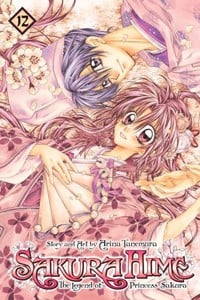Review
by Rebecca Silverman,Sakura Hime: The Legend of Princess Sakura
GN 12
| Synopsis: |  |
||
The final battle has commenced, and Sakura's allies are falling. With the imminent resurrection of Princess Kaguya and the fate of the Moon People, to say nothing of her remaining friends, in her hands, will Sakura have the strength to do what is needed and to find a reason for life to go on? |
|||
| Review: | |||
Spoiler Warning: Read volume 11 before reading this review. With last volume's heart-wrenching loss of Asagiri, Arina Tanemura kicked the finale of Sakura Hime: The Legend of Princess Sakura into high gear. Not that she had been shying away from character deaths previously – while this certainly isn't her darkest series (that distinction goes to Full Moon), it also has been mostly devoid of sweetness and light, despite Tanemura's sparkling art style. Despite the increased trauma for our heroine, however, Tanemura strives to end the series on a high note, or rather a hopeful one. Making Sakura's journey into a barely concealed metaphor for her own concerns about leaving Ribon, the final volume of Sakura Hime tries very hard to say something about what it means to take the future into your own hands and hope. By far the most trauma in this volume comes from the previous book's slaying of Asagiri. While her life had been in danger for the entirety of the series, the manner of her ultimate destruction was fairly awful, and even without that, she had been Sakura's closest confidante for most of her life, in some ways replacing Kai for her. That she should have been killed by Kai in his Enju form just adds to the horror, and it is fair to say that only Oumi's death affected Sakura as strongly. As a literary device, killing off these characters was necessary to force Sakura to make her move, something solidified by the events of this volume. As a reader, however, particularly one within the target audience for the series, the loss of Asagiri is devastating and works well to fuel the confusion that Sakura feels about what her role as the Moon Princess should be. It is difficult to read this volume and not make comparisons with Naoko Takeuchi's Sailor Moon, the other magical girl to claim the title of “moon princess.” There certainly are similarities that can be pointed out, but the major ones are less parallels between two manga that use the Princess Kaguya folktale and more genre conventions for magical girl stories. The theme of self-sacrifice is perhaps used the most interestingly here, as it is not really Sakura who gives up on a future to save everyone else's. This, in fact, sets her apart from many other magical girls, who are willing to go to their deaths with no thought of resurrection if it means that everyone else can be saved. Sakura wants to live. She wants her happy ending with Aoba, she wants to live her human life, and she once she comes to terms with the events of her life, she holds on to the hope that these things will come to pass. This theme of hope is really what makes this volume stand out – when Sailor Moon, Nurse Angel Ririka, and Madoka all make their final leaps, they assume that marks the end. For Sakura, there's no such thing. Along with being an arguably healthier message for young girl readers, this goes along with the story as a personal metaphor for Tanemura's decision to cease publishing in Ribon. (She now publishes in Margaret.) Tanemura's freetalks make it very clear that this is what the story means to her and how conflicted she is about her decision, which does give us an interesting lens through which to look at the story. While we can always take some life lesson from almost anything we read if we are so minded, Tanemura as provided us with the way in which she wants the story interpreted. Depending upon how you feel about such authorial direction, this could be a plus or a major annoyance. If you would prefer to see Sakura Hime as a strict fantasy, simply do not read the author commentaries. Tanemura's art is at a high point for most of the volume, with a number of powerful single or double page images capturing important moments in the story. One of her best illustrations is a line drawing of Sakura transforming – the total lack of gray space makes the picture stand out and imparts and air of “silence” on the story. Another image placed off center on a page with nothing else going on is also powerful, and the small details of some of the images give important messages about the characters' emotional states. (Notice Asagiri's bells and ribbon on Sakura's fan on the cover.) Sakura Hime: The Legend of Princess Sakura is perhaps not Tanemura's most powerful work, but its final volume still has a significant impact on its readers. With the twist on the magical girl theme of self-sacrifice and the metaphor for Tanemura's own fear at striking out, the series ends on a hopeful note, encouraging readers to evaluate their own possibilities...because after all, as Sakura tells us, there's a whole world out there. |
|
The views and opinions expressed in this article are solely those of the author(s) and do not necessarily represent the views of Anime News Network, its employees, owners, or sponsors.
|
| Grade: | |||
Overall : B+
Story : B+
Art : A-
+ Nice hopeful conclusion and message, some very striking images. Good visual reference to the Princess Kaguya story at the very end. |
|||
| discuss this in the forum (4 posts) | | |||
| Production Info: | ||
|
Full encyclopedia details about Release information about |
||